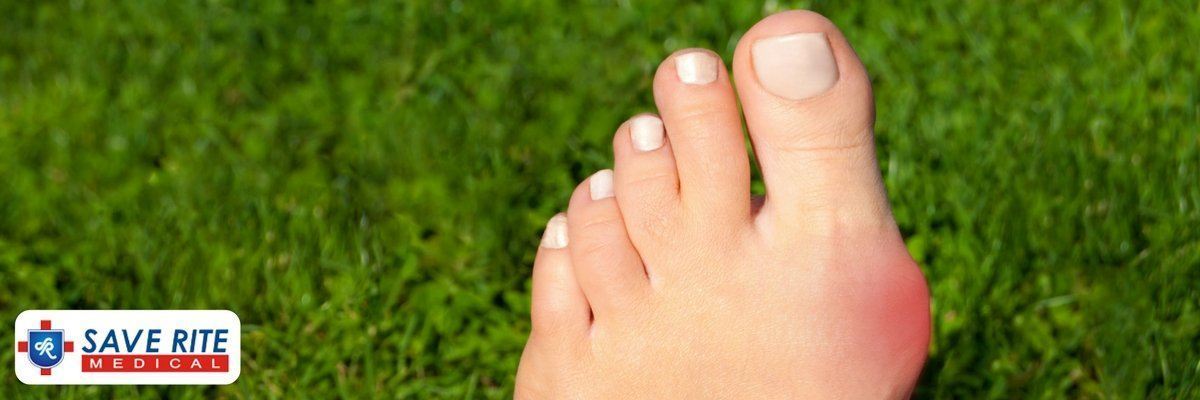Bunions are common enough that you have probably seen one. A bunion causes the big toe to curve toward the little toe, turning at an angle. There's a bony bump at the big toe's base, with this bump possibly being red and painful to the touch. But what is a bunion, really? What is the best bunion treatment? What is a bunion regulator? How do you get bunion relief? Or are you stuck with bunion pain forever?
What is a bunion?
So, what is a bunion? The actual bunion is the red bump on the joint, one developing when the big toe is forced against the next toe. The joint gets bigger and protrudes, hurting on the skin's surface and causing easily inflamed bunion pain when you wear tight shoes or otherwise aggravate the condition. The joint of your little toe can also develop bunions, called bunionettes.
Bunions are often caused or worsened by wearing tight, narrow shoes. They also develop from stress on your foot or arthritis. Some people have bunions as a result of an inherited structural defect.
When you have a bunion, you easily see it and feel the trademark bunion pain. But a doctor still needs to diagnose your condition and provide guidance for its treatment. Your doctor will likely order X-rays and blood tests. Blood tests help diagnose the condition as caused by arthritis or another medical condition, such as gout or an infection. Using these imaging studies and test results, your doctor may prescribe orthopedic shoes, bunion corrector, custom shoe inserts, surgery, medication or other bunion treatment.
Bunion Symptoms
Signs and symptoms of a big toe bunion or small toe bunionette include:
- A bulging, red bump on the outside of your toe joint
- Swelling, bunion pain and redness around your toe joint
- Corns or calluses, such as where the first and second toes overlap
- Bunion pain that is persistent or intermittent
- Limited movement of your toe if the bunion is caused by arthritis
- Curving big toe toward other toes
If you are wondering, "What is a bunion," you are likely already feeling bunion pain. Your best option for bunion relief is to visit a podiatrist or general physician for diagnosis of your condition and possible bunion treatment.
When You Should See Your Doctor
If you need bunion relief, you do not necessarily require medical treatment. But when you see your doctor or one specializing in foot health, such as a podiatrist or orthopedic foot specialist, you gain insight from them about causes, pain relief and bunion treatment.
If you experience any of these issues, you should see your doctor:
- Persistent pain at a big toe's joint, on the small toe's joint or your foot in general
- A visible bump on the big toe joint
- Reduced movement of your big toe, small toe or foot
- Problems finding shoes that fit comfortably or properly because of a protruding bunion
- You need bunion relief due to ongoing discomfort and increasing curve of your toe
- You have more questions about, "What is a bunion," and, "What is a bunion corrector?"
Bunion Causes
In general, what is a bunion and why do we have them? Do they serve a purpose, signal a problem or require treatment? What is a bunion corrector? For answers to these questions, it helps to understand how bunions begin.
Foot problems like bunions usually begin in late teen years and early adulthood. Our feet spread as we age, becoming wider. Problems with our feet become worse over time, as these parts of our bodies take a great deal of wear and tear, supporting our weight.
Bunions run in some families. Weak or poor foot structure can cause this foot problem and others. Arthritis is a common culprit, as is having one leg that is slightly longer than the other. If you have one longer leg, you can develop a bunion on your longer legs big toe.
Men do not get bunions as frequently as women, due to the tight and high-heeled shoe styles women tend to wear. These shoe styles press the foot bones into an unnatural shape. High heels do not just push feet into the shoe shape, they also press body weight down onto the ball of the foot and toes, where bunions occur.
Risk factors leading to bunion development or worsening of bunions include:
- Heredity and inherited foot structure
- Foot injuries
- Footwear choices, wearing high heels or narrow-toed shoes that crowd your toes
- Congenital deformities
- Gender, with more women having bunions than men
- Arthritis, such as inflammatory arthritis conditions
Complications from Bunions
Unless you receive surgical bunion treatment, bunions are permanent. These red, swollen and painful joint bumps can cause complications, including:
- Bursitis, a painful condition caused by inflammation of the bursae, small fluid pads cushioning your bones
- Hammertoe, an abnormal bending of your toe in its middle joint that results in pain and pressure
- Metatarsalgia, a condition causing inflammation and pain in the ball of the foot
Bunion Prevention
Bunions slowly develop, so it is important to take care of your feet in early adulthood before you notice any redness, swelling or pain. It is far easier to prevent a bunion while young than to gain bunion relief later in life.
You should pay attention to your feet throughout your lifetime. If bunions run in your family, pay particular attention to your foot shape. If you notice changes, see your doctor for further bunion prevention advice.
Strengthen your feet by exercising them. You can improve foot strength and flexibility by learning to pick up small objects with your toes, such as a pencil or pebble.
Women should avoid wearing pointed-toe shoes or high heels and men should also wear shoes that fit properly and provide toes with ample room. Shoes should not pinch or cramp your toes.
Bunion Treatment
Getting the bunion relief you need starts with diagnose and bunion treatment. Your doctor can diagnose your bunion by physical exam. X-rays providing images of your internal foot structure to help the doctor identify why the bunion occurred and how severe your condition is, for appropriate treatment.
There are multiple treatment options for bunions. These vary according to your foot's condition, how much pain you are feeling and other factors. The cause of your bunion also affects your doctor's recommendations for treatment.
Conservative, non-surgical treatments for bunions help relieve pain and pressure of your bunions. These methods include:
- Changing shoes, to everyday wear of roomy shoes that fit you properly
- Bunion pads or shoe inserts to correct the bunion pressure, without putting pressure elsewhere on your foot
- Bunion corrector or a splint, a splint typically worn at night while sleeping to correct the alignment of your toe and joint, repositioning them gradually over an extended period of wear
- Orthopedic shoes, with specially designed insoles and uppers to remove pressure from your bunion joint and reshape your foot
- Padding and taping, using non-medicated bunion pads to position your foot in a normal position to reduce stress on the bunion and relieve pain similar to a bunion corrector
- Medications, such as acetaminophen, ibuprofen and naproxen sodium to control bunion pain or cortisone injections for longer-term relief
- Over-the-counter or orthotic shoe inserts, evening the distribution of foot pressure, reducing symptoms and preventing worsening of the bunion
- Ice packs, used when you have been on your feet for too long or to relieve inflammation and soreness
Bunion Surgery
When conservative treatments like a bunion corrector, ice packs, medications, shoe inserts, padding and taping do not work, surgery may be your best option for bunion pain relief. But surgery is only recommended when your pain significantly affects your daily life and activities.
For surgery to be worthwhile, your bunion problem and symptoms should be severe. Surgery is not an easy solution just because you do not like the appearance of your bunion. Surgery risks often outweigh the benefits for your bunion problem.
You need to have a thorough conversation with your doctor about what to expect from bunion surgery, what recovery will be like and whether other options - such as a bunion corrector - are better suited for your condition. It is usually best to try the other options first, such as pain relief, shoe changes, a bunion corrector and orthotic inserts.
Bunion surgery is called a bunionectomy. This is a removal of the bunion, conducted in a hospital or surgery center. A bunionectomy is a day surgery in most cases, enabling you to return home after the procedure. You may receive local anesthesia and sedation or your doctor may recommend general anesthesia to put you fully to sleep for the surgery.
There are multiple types of bunion surgeries. Your surgeon may choose to realign your big toe by cutting ligaments at the big toe joint. Or the surgeon may have the bone cut through an osteotomy procedure. The surgeon shaves off excess bone and inserts wires or screws to keep your bones in line.
Your bunion surgery may include:
- Removing swollen tissue from the big toe joint
- Permanently fusing bones of your affected joint
- Removing part of your bone to straighten your big toe
- Straightening the abnormal big toe joint angle by aligning the long bone between the back of your foot and your big toe
Recovery from Bunion Surgery
Recovery from bunion surgery usually takes several weeks to a few months. But you may be able to walk on your foot immediately after surgery. You will need to wear proper shoes after bunion surgery recovery, as you will probably not be able to wear narrow styles.
Some possible complications of bunion surgery include:
- Return of the bunion
- Undercorrection or overcorrection of the bunion problem, so your toe points inward
- Continuing, uncorrected pain
- Inability to move the big toe as you could before surgery
Sources
We hope you found this article to provide value in your search for bunion relief. If you have any questions please feel free to contact us at anytime or leave a comment below. Know you’re not alone when it comes to bunions and there’s steps you can take for relief and prevention.
- Marc Kaplan
CEO, Save Rite Medical

Marc Kaplan is founder and CEO of Save Rite Medical — the leading provider of wholesale medical supplies. A salesman by day and educator by night, Marc enjoys providing valuable ways and alternatives to living a healthier lifestyle.


